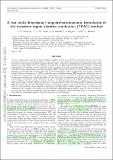Files in this item
A fast multi-dimensional magnetohydrodynamic formulation of the transition region adaptive conduction (TRAC) method
Item metadata
| dc.contributor.author | Johnston, C. D. | |
| dc.contributor.author | Hood, A. W. | |
| dc.contributor.author | De Moortel, I. | |
| dc.contributor.author | Pagano, P. | |
| dc.contributor.author | Howson, T. A. | |
| dc.date.accessioned | 2021-07-15T09:30:14Z | |
| dc.date.available | 2021-07-15T09:30:14Z | |
| dc.date.issued | 2021-10 | |
| dc.identifier | 274841980 | |
| dc.identifier | f0780361-7d05-4f7f-be10-cc52917dd012 | |
| dc.identifier | 000702520600014 | |
| dc.identifier | 85116412273 | |
| dc.identifier.citation | Johnston , C D , Hood , A W , De Moortel , I , Pagano , P & Howson , T A 2021 , ' A fast multi-dimensional magnetohydrodynamic formulation of the transition region adaptive conduction (TRAC) method ' , Astronomy & Astrophysics , vol. 654 , A2 . https://doi.org/10.1051/0004-6361/202140987 | en |
| dc.identifier.issn | 0004-6361 | |
| dc.identifier.other | BibCode: 2021arXiv210603989J | |
| dc.identifier.other | ORCID: /0000-0002-1452-9330/work/102330089 | |
| dc.identifier.other | ORCID: /0000-0003-2620-2068/work/102725149 | |
| dc.identifier.other | ORCID: /0000-0003-4023-9887/work/102725790 | |
| dc.identifier.other | ORCID: /0000-0002-4895-6277/work/102725803 | |
| dc.identifier.uri | https://hdl.handle.net/10023/23574 | |
| dc.description | The research leading to these results has received funding from the UK Science and Technology Facilities Council (consolidated grant ST/N000609/1), the European Union Horizon 2020 research and innovation programme (grant agreement No. 647214). IDM received funding from the Research Council of Norway through its Centres of Excellence scheme, project number 262622. CDJ acknowledges support from the International Space Science Institute (ISSI), Bern, Switzerland to the International Teams on “Observed Multi-Scale Variability of Coronal Loops as a Probe of Coronal Heating” and “Interrogating Field-Aligned Solar Flare Models: Comparing, Contrasting and Improving”. | en |
| dc.description.abstract | We have demonstrated that the transition region adaptive conduction (TRAC) method permits fast and accurate numerical solutions of the field-aligned hydrodynamic equations, successfully removing the influence of numerical resolution on the coronal density response to impulsive heating. This is achieved by adjusting the parallel thermal conductivity, radiative loss, and heating rates to broaden the transition region (TR), below a global cutoff temperature, so that the steep gradients are spatially resolved even when using coarse numerical grids. Implementing the original 1D formulation of TRAC in multi-dimensional magnetohydrodynamic (MHD) models would require tracing a large number of magnetic field lines at every time step in order to prescribe a global cutoff temperature to each field line. In this paper, we present a highly efficient formulation of the TRAC method for use in multi-dimensional MHD simulations, which does not rely on field line tracing. In the TR, adaptive local cutoff temperatures are used instead of global cutoff temperatures to broaden any unresolved parts of the atmosphere. These local cutoff temperatures are calculated using only local grid cell quantities, enabling the MHD extension of TRAC to efficiently account for the magnetic field evolution, without tracing field lines. Consistent with analytical predictions, we show that this approach successfully preserves the properties of the original TRAC method. In particular, the total radiative losses and heating remain conserved under the MHD formulation. Results from 2D MHD simulations of impulsive heating in unsheared and sheared arcades of coronal loops are also presented. These simulations benchmark the MHD TRAC method against a series of 1D models and demonstrate the versatility and robustness of the method in multi-dimensional magnetic fields. We show, for the first time, that pressure differences, generated during the evaporation phase of impulsive heating events, can produce current layers that are significantly narrower than the transverse energy deposition. | |
| dc.format.extent | 16 | |
| dc.format.extent | 31709052 | |
| dc.language.iso | eng | |
| dc.relation.ispartof | Astronomy & Astrophysics | en |
| dc.subject | Magnetohydrodynamics (MHD) | en |
| dc.subject | Sun: transition region | en |
| dc.subject | Sun: corona | en |
| dc.subject | Sun: chromosphere | en |
| dc.subject | Sun: flares hydrodynamics | en |
| dc.subject | QB Astronomy | en |
| dc.subject | QC Physics | en |
| dc.subject | NDAS | en |
| dc.subject.lcc | QB | en |
| dc.subject.lcc | QC | en |
| dc.title | A fast multi-dimensional magnetohydrodynamic formulation of the transition region adaptive conduction (TRAC) method | en |
| dc.type | Journal article | en |
| dc.contributor.sponsor | European Research Council | en |
| dc.contributor.sponsor | Science & Technology Facilities Council | en |
| dc.contributor.institution | University of St Andrews. Applied Mathematics | en |
| dc.contributor.institution | University of St Andrews. Office of the Principal | en |
| dc.identifier.doi | 10.1051/0004-6361/202140987 | |
| dc.description.status | Peer reviewed | en |
| dc.identifier.url | http://adsabs.harvard.edu/abs/2021arXiv210603989J | en |
| dc.identifier.grantnumber | 647214 | en |
| dc.identifier.grantnumber | ST/S000402/1 | en |
This item appears in the following Collection(s)
Items in the St Andrews Research Repository are protected by copyright, with all rights reserved, unless otherwise indicated.

